Did you know that Q, James Bond’s favourite quartermaster, was actually a former Strathbungo resident? The story comes courtesy of the Herald , and the sharp eyes of local resident David Cook.
Imagine the curtains twitching back in 1956 when the CID called at 17 Regent Park Square. They wanted to question the licence-holder of a revolver matching the gun used by one of Scotland’s most notorious serial killers. Geoffrey Boothroyd, a young technical rep at ICI, told them that his gun was actually down south being illustrated for the cover of Ian Fleming’s next James Bond novel, From Russia with Love.
That old excuse…
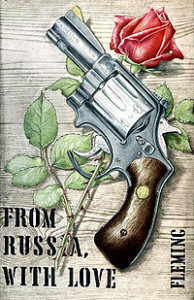
Cover of first edition, From Russia with Love.
And it was true. Boothroyd, a gun collector, had written to Fleming earlier that year to say that Bond’s .25 Beretta was “really a lady’s gun”. He suggested instead a manly Smith & Wesson .38. Little did he know that it was also the weapon of choice for one Peter Manuel, then on a murderous spree that would eventually claim seven lives, the including three in Burnside.
The detectives eventually got their man and Manuel got justice at the end of a rope. Boothroyd and Fleming continued their friendly correspondence . At the end of From Russia with Love, Rosa Klebb managed to stab Bond with her famous boot, partly because his Beretta got caught in his holster.

The modified snub-nosed Smith & Wesson M&P from the cover of From Russia with Love, now in the Royal Armouries museum. Credit: Royal Armouries
In his next novel, Dr No, Fleming included a whole chapter in which Bond was introduced by M to the armourer, Major Boothroyd, “the greatest small-arms expert in the world”. He confiscated Bond’s Beretta – “Ladies’ gun, sir” – for a Walther PPK, with the Smith & Wesson Centennial Airweight .38 revolver as back up. A new holster was also recommended, and all was based closely on Geoffrey Boothroyd’s advice. Even Daniel Craig still used the Walther PPK.
Oddly the character Q never appeared in Fleming’s novels; he only referred to Q Branch, suppliers of gadgets. Major Boothroyd appeared just the once, and it wasn’t clear he was from Q Branch either.
Boothroyd himself became firearms consultant for Dr No, the first Bond movie, and also advised on such matters as how to set an ocean on fire – no doubt his work at ICI came in handy. Peter Burton played Major Boothroyd in the movie version of the above scene from Dr No.
It was only in the second movie, From Russia with Love, that Major Boothroyd also became known as Q, and was played famously by Desmond Llewellyn, in that movie and for the subsequent 36 years.

Geoffrey Boothroyd
Geoffrey Boothroyd was quite an eccentric who once told Fleming: “I cherish a dream that one day a large tiger or lion will escape from the zoo or a travelling circus and I can bag it in Argyll Street.” That never happened, but he went on to become one of the world’s leading authorities on shotguns and handguns.
Mr Boothroyd himself, in a 1964 short presented by Sean Connery , explains his reasoning behind his choice of weapons. The film appears to have been shot inside his Strathbungo home; although by this time he had moved from 17 to 11 Regent Park Square, where he lived from 1956 to 1971. A recent resident of No 11 recalls his parents purchasing the house from the Boothroyds, and remembers the house being full of weapons, including a Gatling gun in the living room. Does the current resident recognise it?
I am slowly amassing a history of Strathbungo, including stories of former residents of note such as this. If you have any stories to tell, please get in touch.
Addendum
For those who are interested in the detail, I have uncovered the full correspondence with Fleming in an article Fleming wrote for Sports Illustrated in March 1962 .
The Guns Of James Bond
James Bond is fictional. His weapons are not. Here is the inside story of why he abandoned his favorite gun
Ian FlemingJames Bond is the hero of a succession of immensely popular mystery novels by the British author Ian Fleming. Bond is an agent of the British Secret Service, and the charm he exerts on his readers — who include the President of the United States — is based partly on the drama of his assignments but even more on the factual detail of each Fleming book. Although Bond’s extravagant adventures (between torrid love affairs with improbably beautiful and compliant ladies he has been tossed to a giant squid, tied to a buzz saw and poisoned by a drug derived from the sex organs of the Japanese globefish) have caused his originator to be described as “a sort of British Mickey Spillane,” Author Fleming is really a reserved English gentleman with a passion for accuracy. As such, he willingly listened and learned when Gun Expert Geoffrey Boothroyd wrote him concerning what Boothroyd thought were errors in Bond’s choice of weapons. Fleming was so pleased with Boothroyd’s constructive criticism that he not only followed his suggestions but incorporated Boothroyd into his next book as “The Armourer” of the British Secret Service. The article that begins on the next page is Fleming’s account of his correspondence with Boothroyd. It is both an authoritative discussion of small arms and a fascinating detective story in itself.
Enter Boothroyd
Some reviewers of my books about James Bond have been generous in commending the accuracy of the expertise which forms a considerable part of the background furniture of these books. I may say that correspondents from all over the world have been equally enthusiastic in writing to point out errors in this expertise, and the mistakes I have made, approximately one per volume, will no doubt forever continue to haunt my In basket.
But it is true that I take very great pains over the technical and geographical background to James Bond’s adventures, and during and after the writing of each book I consult innumerable authorities in order to give solidity and integrity to his exploits. Without this solid springboard, there would perhaps be justification for the frequent criticisms that James Bond’s adventures are fantastic, though I maintain that such criticism comes from people who simply do not read the newspapers or who have not taken note of the revealing peaks of the great underwater iceberg that is Secret Service warfare. The frogman mystery of Commander Crabb, Khokhlov and the bullet-firing cigarette case with which his Russian masters hoped to have a West German propaganda expert assassinated, the whole of the U-2 affair—what incidents in my serial biography of James Bond are more fantastic than these?
It was in pursuit of verisimilitude that my friendship with Geoffrey Boothroyd was born in May 1956, and I think it may be an interesting sidelight on the work of two enthusiasts, one in thriller writing and the other in gun lore, for me to print here our correspondence and then to recount the rather bizarre sequel to the long and forceful letter that came to me one day from Glasgow.
BOOTHROYD TO FLEMING, MAY 23RD, 1956
“I have, by now, got rather fond of Mr. James Bond. I like most of the things about him, with the exception of his rather deplorable taste in firearms. In particular, I dislike a man who comes into contact with all sorts of formidable people using a .25 Beretta. This sort of gun is really a lady’s gun, and not a really nice lady at that. If Mr. Bond has to use a light gun he would be better off with a .22 rim fire; the lead bullet would cause more shocking effect than the jacketed type of the .25.
“May I suggest that Mr. Bond be armed with a revolver? This has many advantages for the type of shooting that he is called on to perform and I am certain that Mr. Leiter [ Bond’s sometime associate] would agree with this recommendation. The Beretta will weigh, after it has been doctored, somewhere under 1 pound unloaded. If Mr. Bond gets himself an S & W .38 Special Centennial Airweight he will have a real man-stopper weighing only 17 ounces loaded. The gun is hammerless so that it can be drawn without catching in the clothing and has an overall length of 6½ inches. Barrel length is 2 inches, but note that it is not ‘sawn off.’ No one who can buy his pistols in the States will go to the trouble of sawing off pistol barrels as they can be purchased with short 2-inch barrels from the manufacturers. In order to keep down the bulk the cylinder holds five cartridges, and these are standard .38 S & W Special. It is an extremely accurate cartridge and when fired from a 2-inch barrel has, in standard loading, a muzzle velocity of almost 700 ft./sec. and muzzle energy of around 200 ft./lbs. This is against Bond’s .25 Beretta with muzzle velocity of 758 ft./sec. but only 67 ft./lbs. muzzle energy. So much for his personal gun. Now he must have a real man-stopper to carry in the car. For this purpose the S & W .357 Magnum has no equal except the .44 Magnum. With the .357, Bond can still use his S & W .38 Special cartridges, although not vice versa. The .357 Magnum can be obtained in barrel lengths as follows: 3½ inches, 5 inches, 6 inches, 6½ inches and 8? inches long. With a 6½-inch barrel and adjustable rear sights Bond could do some really effective shooting, getting with the .357 Magnum a muzzle velocity of about 1,300 ft./sec. and a muzzle energy of nearly 600 ft./lbs. Figures like these give an effective range of 300 yards, and it’s very accurate, too—1-inch groups at 20 yards on a machine rest.
“With these two guns Bond would be able to cope with really quick-draw work and long-range effective shooting.”
“Now to gun harness, rigs or what have you. First of all, not a shoulder holster for general wear, please. I suggest that the little Centennial Airweight be carried in a ‘Lightning’ Berns-Martin Triple Draw holster. This type of holster holds the gun in by means of a spring and can be worn on the belt or as a shoulder holster. I have played about with various types of holster for quite a time now and this one is the best. Here are descriptions of how it works—as a belt holster and as a shoulder holster:
“A Series. Holster worn on belt at right side. Pistol drawn with right hand.
“1) Ready position. Note that the gun is not noticeable.
“2) First movement. Weight moves to left foot. Hand draws back coat and sweeps forward to catch butt of pistol. Finger outside holster.
“3) Gun comes out of holster through the split front.
“4) In business.
“This draw can be done in 3/5ths of a second, and with practice and lots of it you could hit a figure at 20 feet in that time.
“B Series. Shoulder holster. Gun upside down on left side. Held in by spring. Drawn with right hand.
“1) First position.
“2) Coat drawn back by left hand, gun butt grasped by right hand, finger outside holster.
“3) Gun coming out of holster.
“4) Bang! You’re dead.
“C Series. Holster worn on belt, as in A, but gun drawn with left hand.
“1) Draw commences. Butt held by first two fingers of left hand. Third finger and little finger ready to grasp trigger.
“2) Ready to shoot. Trigger is pulled by third and little finger, thumb curled round stock, gun upside down.
“This really works but you need a cutaway trigger guard.
“D Series. Holster worn on shoulder, as in B, but gun drawn with left hand.
“1) Coat swept back with left hand and gun grasped.
“2) Gun is pushed to the right to clear holster and is ready for action.
“I trust this will explain what I mean. The gun used is an S & W .38 Special with a sawn-off barrel to 2½ inches. (I know this contradicts what I said over the page but I can’t afford the $64 needed, so I had to make my own.) It has target sights—ramp front sight, adjustable rear sight—rounded butt, special stocks and a cutaway trigger guard.
“If you have managed to read this far I hope that you will accept the above in the spirit that it is offered. I have enjoyed your books immensely and will say right now that I have no criticism of the women in them, except that I’ve never met any like them and would doubtless get into trouble if I did.”
FLEMING TO BOOTHROYD, 31ST MAY
“I really am most grateful for your splendid letter of May 23rd.
“You have entirely convinced me, and I propose, perhaps not in the next volume of James Bond’s memoirs but in the subsequent one, to change his weapons in accordance with your instructions.
“Since I am not in the habit of stealing another man’s expertise, I shall ask you in due course to accept remuneration for your most valuable technical aid.
“Incidentally, can you suggest where I can see a .38 Airweight in London? Who would have one?
“As a matter of interest, how do you come to know so much about these things? I was delighted with the detailed explanation of how the holster operates and greatly impressed. If ever there is talk of making films of some of James Bond’s stories in due course, I shall suggest to the company concerned that they might like to consult you on some technical aspects. But they may not take my advice, so please do not set too much store by this suggestion.
“From the style of your writing it occurs to me that you may have written books or articles on these subjects. Is that so?
“Bond has always admitted to me that the .25 Beretta was not a stopping gun, and he places much more reliance on his accuracy with it than in any particular qualities of the gun itself. As you know, one gets used to a gun and it may take some time for him to settle down with the Smith & Wesson. But I think M [ Bond’s chief in the Secret Service, always referred to by the initial] should advise him to make a change, as also in the case of the .357 Magnum.
“He also agrees to give a fair trial to the Berns-Martin holster, but he is inclined to favour something a little more casual and less bulky. The well-worn chamois leather pouch under his left arm has become almost a part of his clothes, and he will be loth to make a change, though, here again, M may intervene.
“At the present moment Bond is particularly anxious for expertise on the weapons likely to be carried by Russian agents, and I wonder if you have any information on this.
“As Bond’s biographer I am most anxious to see that he lives as long as possible and I shall be most grateful for any further technical advices you might like me to pass on to him.
“Again, with very sincere thanks for your extremely helpful and workmanlike letter.”
BOOTHROYD TO FLEMING, 1ST JUNE
“I was truly delighted to receive your charming letter. This is the first time I have had either the inclination or the temerity to write to the author of any books that pass through my hands; quite frankly, in many cases the rest of the material is not worth backing up by correct and authentic ‘gun dope.’ You have, incidentally, enslaved the rest of my household, people staying up to all hours of the night in an endeavour to finish a book before some other interested party swipes it.
“If I am to be considered for the post of Bond’s ballistic man I should give you my terms of reference. Age 31, English, unmarried. Member of the following Rifle Clubs: N.R.A., Gt. Britain, English Twenty Club, National Rifle Association of America (nonresident member), West of Scotland Rifle Club, Muzzle Loaders Association of Gt. Britain. I shoot with shotgun and rifle—target, clay pigeon, deer but, to my deep regret, no big game. (I cherish a dream that one day a large tiger or lion will escape from the zoo or a travelling circus and I can bag it in Argyle St., Glasgow, or Princes St., Edinburgh.) I do both muzzle-loading and breech-loading shooting, load my own shotgun and pistol ammunition. Shoot with pistol, mainly target, and collect arms of various sorts. My present collection numbers about 45, not as many as in some collections, but all of mine go off and have been fired by me. Shooting and gun lore is a jolly queer thing; most people stick to their own field, rather like stamp collectors who specialise in British Colonials. Such people shoot only with the rifle and often only .303, or only .22. There are certain rather odd types like myself who have a go at the lot, including archery. It’s a most fascinating study if one has the time, and before long it’s either given up and you collect old Bentleys or it becomes an obsession. We all have a pet aspect of our hobby, and mine at present is this business of ‘draw and shoot,’ or the gun lore of close-combat weapons. On reflection it is pretty stupid, as it’s most unlikely that I shall ever do this sort of thing in earnest, but it has the pleasant advantage of not having, very many fish in the pond and however you look at it you are an authority. In Scotland I have the space to do this sort of thing, and have two friends who are not 150 miles away to talk to. I seem to have taken up a lot of space on this—must want to impress you!
“Now to the work. The S & W Airweight model is not common in England, at least in a shop. I therefore enclose S & W’s latest catalogue, which shows current models. Perhaps you would let me have this back, as I have to send it off to another chap who is going to S. America and he wants to buy a gun when he gets there. The only people in London who may have S & W new-model pistols will be Thomas Bland and Sons, William IVth St., Strand, and Cogs-well and Harrison. Current demand for pistols in this country is restricted to folks going off to Kenya, Malaya, etc.
“Some people have bought modified guns from Cogswell and Harrison. This type is a cut-down S & W .38 Special Military & Police Model. I’m sorry I can’t help regarding an actual inspection of a new-model S & W. The only people who may have one are Americans in this country or James Bond.“Re holsters. A letter to S. D. Myres Saddle Co., 5030 Alameda Blvd., El Paso, Texas, will bring you their current holster catalogue. The Berns-Martin people live in Calhoun City, Mississippi, and a note to Jack Martin, who is a first-class chap and a true gunslinger, will bring you illustrations of his work. Bond’s chamois leather pouch will be ideal for carrying a gun, but God help him if he has to get it out in a hurry. The soft leather will snag and foul on the projecting parts of the gun and he will still be struggling to get the gun out when the other fellow is counting the holes in Bond’s tummy. Bond has a good point when he mentions accuracy. It’s no good shooting at a man with the biggest gun one can hold—if you miss him. The thing about the larger calibres is, however, that when you hit someone with a man-stopping bullet they are out of the game and won’t lie on the floor still popping off at you.
“Regarding weapons carried by Russian agents. I have had little experience of using weapons from behind the Iron Curtain or of meeting people who use them. I did once meet a Polish officer who was some sort of undercover man and cloak-and-dagger merchant and he used an American Colt automatic in .38 cal. I would suggest that a member of SMERSH [Fleming’s name for the Soviet secret police] would in all probability make his choice from the following, and use either a Luger with an 8-inch, 10-inch, 12-inch or 16-inch barrel with detachable shoulder stock or a Mauser 7.63 automatic with shoulder stock for assassination work from a medium distance, say across a street. A short-barrel 9-mm. Luger (Model 08), 4-inch barrel, might be carried for personal protection, although it is rather large to carry about. In the same class as the Luger and having equal availability to someone employed by SMERSH would be the Polish Radom Model 35. This takes the standard Luger cartridge and also the more powerful black-bulleted machine pistol 9-mm. round. It closely resembles the Colt Model 1911, or perhaps more so the Colt 9-mm. Commander. Another choice would be the Swedish 9-mm. Lahti. This is a strong and very well-made pistol strongly reminiscent of the Luger. It weighs 44 ounces loaded as compared with 34 ounces for the short-barrel Luger.
“The Russian Tokarev pistol Model 30 appears to be the standard sidearm of the Soviets, and once again is a close copy of John Browning’s basic pistol. Calibre 7.62 Russian or 7.63 Mauser and designed in the 1930s. This pistol looks like the Belgian Browning auto pistol made by Fabrique Nationale, Liege, except that it has an external hammer. There is no manual safety, and if the gun is carried loaded at full cock, obvious safety hazards exist. Carried at half-cock the gun undoubtedly would be safer, but the hammer design is such that cocking the hammer is not an easy job and the first shot would be a slow one from the draw.
“In this same general class would be the Walther P-38, which was used by the German army as a replacement for the Luger. Evidence is that the pistol is not quite as good as it might be, this being probably due to production difficulties met with during the war. This also takes the 9-mm. cartridge. One of the advantages of the Walther is that it can be used double-action, i.e., there is no need to cock the hammer for the first shot provided the barrel has a cartridge ‘up the spout.’ After the first shot the gun operates as does the normal auto pistol.
“For carrying on the person the following arms could be chosen: Walther PPK 7.65-mm., Mauser HS c. 7.65-mm. or the Walther PP in 7.65-mm. cal., Sauer Model 38 H in 7.65-mm. calibre.
“All of the above were tested for accuracy, endurance, etc., by the U.S. Army Ordnance Corps in 1948. Also included were the Japanese Nambu and the American Colt 1911A1 Auto. In accuracy the Nambu came first, followed by the Russian Tokarev, the Sauer being third. Colonel F. S. Allen, USAF, who wrote an article on the findings of the O.C. tests, concluded by saying that for an emergency defence weapon he would have a lightweight .38 Special, a decision which I heartily agree with.
“I hope that when the SMERSH operative, armed perhaps with one of the guns mentioned above, meets Bond, your friend will be able to adequately demonstrate the effectiveness of Anglo-American cooperation, a competent English pistol man behind a truly lethal .38 Special.
“The above should give some idea of the type of weapon likely to be carried by SMERSH men, the Russians being rather similar to ourselves where firearms are concerned. They do not hesitate to use foreign weapons if they are better than those produced by themselves. An instance of this was their use of the Finnish Soumi light machine gun during the last war. In brief, one could be safe in arming an agent of SMERSH with the Tokarev, Radom or Luger, in that order. Pocket weapons would be either German Mauser or Walther.
“Please convey warmest regards to Mr. Bond and assure him of my closest interest in his activities and very willing cooperation in his ‘gun needs’ for as long as he wishes. Instead of remuneration, an introduction to Solitaire [one of Fleming’s glamorous heroines] would more than adequately compensate me for the little trouble I have taken. Between you and me, I quite enjoy it.”
FLEMING TO BOOTHROYD, 22ND JUNE, 1956
“I have been away in Vienna, and seeing a man about a flying saucer in Paris, and I have only just had your letter of June 1st with enclosures.
“Thank you again most sincerely for taking all this trouble, and also for sending me the very interesting information on your own career and hobbies. You certainly seem to lead a full life!
“I am intrigued by your mention of archery. I have long thought that Bond could do a lot of damage with a short steel bow and appropriate arrows. What do you think of this suggestion, and do you know someone who would instruct me on weapons, ranges and so forth?“I am returning the Smith & Wesson catalogue and, since I am off to New York at the end of July, I propose to purchase a Centennial Airweight.
“Would this not, in any case, be the best weapon for Bond? There is no hammer to catch in his clothes.“I am vastly intrigued by your own M & P model and by the way you have beautified it. Bond will certainly adopt your two-thirds trigger guard. I don’t intend to go too deeply into the holster problem and I intend to accept your expertise in the matter of the Berns-Martin holster.
“Only one basic problem remains in changing Bond’s weapon, and that is in the matter of a silencer. It would have to be an extremely bulky affair to silence a .38 of any make and I simply can’t see one fitted to the Centennial. Have you any views?
“As a matter of fact, a change of Bond’s weapons is very appropriate. In his next adventure, which deals with an intricate plot by SMERSH to kill Bond, he finally gets into really bad trouble when the Beretta—with silencer—sticks in his waistband.
“It is too late now to save him from the consequences, but in the book that follows, if I have the energy and ingenuity to write one, I shall start off with a chapter devoted entirely to his re-equipment along the lines you suggest.
“But in this chapter the matter of a silencer will have to be overcome and, in fact, in his latest adventure, which I mention above, he could hardly have used an unsilenced .38 in the room at the Ritz Hotel in Paris where he wrestles fruitlessly with his snarled gun.
“Turning to foreign weapons, have you by any chance got the article by Colonel Allen on the findings of the O.C. tests, or could you tell me where it appeared? It sounds most useful to my purposes.
“Once again, please accept my very warm thanks for your kindness in taking Bond’s armoury in hand and sorting it out. As a small recompense for your trouble I am sending you a shiny and rather expensive book on Odd Weapons which has just appeared and which perhaps you do not possess. It is not exactly on your beat, but it may entertain.”
BOOTHROYD TO FLEMING, JUNE 29TH
“Silencers. These I do not like. The only excuse for using one is on a .22 rifle using low-velocity ammunition, i.e., below the speed of sound. With apologies, I think you will find that silencers are more often found in fiction than in real life. An effective silencer on an auto pistol would be very ponderous and would spoil the balance of the gun, and to silence a revolver would be even more difficult due to the gas escape between the cylinder and the barrel. Personally I can’t at this stage see how one would fit a silencer to a Beretta unless a special barrel were made for it, as the silencer has to be screwed on to the barrel, and as you know there is very little of the barrel projecting in front of the slide on the Beretta.
“This business of using guns in houses or hotels is a very strange one. So few people are familiar with what a gun sounds like that I would have little hesitation in firing one in any well-constructed building. This remark is only regarding the noise or nuisance value. I would not fire a pistol in a room without some thoughts on the matter, as bullets have a bad habit of bouncing off things and coming home to roost. I have fired .455 blanks at home on several occasions, even in the middle of the night, without any enquiries being made. The last time was at Christmas when I blew out the candles on the Christmas cake with a pistol and blanks. To conclude, if possible don’t have anything to do with silencers.”
FLEMING TO BOOTHROYD, EXTRACT FROM A LETTER DATED 12TH JULY
“I sympathize with you about not liking silencers, but the trouble is that there are often occasions when they are essential to Bond’s work. But they are clumsy things and only partially effective, though our Secret Services developed some very good ones during the war, in which the bullet passed through rubber baffles. I have tried a Sten gun silenced with one of these and all one could hear was the click of the machinery.
“I rather like the picture of you going through life firing bullets ‘in any well-constructed building’! But I agree with you that one could probably get away with a single shot in a Paris hotel bedroom. Your Christmas trick would, of course, be helped by its association in a listener’s mind with cracker-pulling.”
The late summer is the time of year when, spurred on by Mr. Michael Howard of Jonathan Cape Ltd., my publishers, I put the final corrections to the typescript of the current James Bond adventure, usually written in January and February. Michael Howard wants to get the typescript into page proofs, to which I must give a last polish in September so that he can go to print for publication six months later, around Eastertime. Late summer is also the time when he and I get our heads together about the design of an appropriate jacket for the book. The volume I was working on at the time of my correspondence with Geoffrey Boothroyd was From Russia with Love, and, with the correspondence in mind and remembering the excellent trompe-l’oeil jacket for Raymond Chandler’s The Simple Art of Murder, published by Hamish Hamilton Ltd. in 1950, my idea for a jacket was a gun crossed with a rose. So I decided to approach Dickie Chopping, who is probably the finest trompe-l’oeil painter in the world and for whose work I have a great admiration.
Dickie Chopping having agreed in principle, the next requirement was a suitable gun. I at once thought of Geoffrey Boothroyd’s favourite—the S & W .38 Special M & P whose barrel he had sawn to 2½ inches, and whose trigger guard he had cut away for quicker shooting, and I wrote asking for the loan of the gun.
Geoffrey Boothroyd agreed. His beautiful gun came down to me by registered post and was sent on to Dickie Chopping, who at once set to work, commenting in a letter around the middle of September, “It has been the very devil to paint, but fascinating.”
And then fate stepped in via an urgent trunk call from Geoffrey Boothroyd.
On the night of September 16th, 1956 there took place in Glasgow a multiple crime, later to become famous as the “Burnside Murders.” Three people were murdered on this bloody night—wife, daughter and sister-in-law—and recovery of the bullets from the corpses revealed that they were of .38 calibre.
The police had a record of all owners of .38 weapons in the neighbourhood, and Geoffrey Boothroyd, on the list of suspects, received an urgent visit from a police sergeant asking to see his Smith & Wesson. A thoroughly worried Boothroyd had to admit that this was in the hands of a certain Ian Fleming living in London, and he now warned me over the telephone to expect an early visit from Scotland Yard.
With the C.I.D.’s deadly efficiency, the visit resulted in a matter of hours, and it was fortunate that I not only had an alibi for the night in question but also a firearms certificate covering a .25 Browning automatic which I had occasionally carried during the war on Naval Intelligence duties and a Colt Official Police .38 Special revolver which was presented to me as a memento of our friendship by General “Wild Bill” Donovan, head of the American Secret Services known as O.S.S., with whom I had had frequent and close association in wartime.
But of course I did not possess the suspect gun! This was in the hands of Dickie Chopping in his studio in Essex! My imagination boggled at the impact of a police visit on this sensitive person, who would, in any case, obviously be without a firearms certificate. Fortunately the sergeant from the C.I.D., having read through my correspondence with Geoffrey Boothroyd and Dickie Chopping and after making copious notes, accepted my plea not to descend upon poor Chopping so long as the suspect gun could be quickly returned to me and so back to its rightful owner.
As luck would have it, that same afternoon Dickie Chopping came to see me with his completed painting for the book jacket and with the gun, so a telephone call to Scotland Yard and the hasty despatch to Glasgow of the incriminating weapon closed the incident so far as we were concerned.As to the Burnside Murders, the husband, a prominent Glasgow man, was arrested, but was later released, and with the aid of his solicitor eventually laid the trap which brought the true culprit to account.
The man responsible was a certain Peter Manuel. He was arrested, and these three and several other murders were laid at his door. Manuel conducted his own defence and was later convicted and executed for his crimes. His gun had, in fact, been a Webley and not a Smith & Wesson. Both are made in .38 calibre but the rifling is different.
The Chopping jacket was a tremendous success, both in England and America, and from that day on he and I and Michael Howard of Cape’s have devised all the James Bond jackets, which have now become something of a hallmark with the book trade and have earned prizes for Cape’s.
With the page proofs of From Russia with Love finally out of the way, my mind was busy with the next in the series of James Bond’s adventures—Doctor No—and I retired as usual to my small house in Jamaica to write this in January and February of 1957. It is in this book that “The Armourer,” a certain “Major Boothroyd,” is called in by M to give judgment on James Bond’s weapons, the inadequacy of which at the end of From Russia with Love so nearly cost him his life.
Major Boothroyd echoes the strictures of Geoffrey Boothroyd, and James Bond, much to his preliminary annoyance, departs on his mission against the redoubtable Doctor No with a Walther PPK 7.65-mm. with a Berns-Martin holster for close work and a Smith & Wesson .38 Centennial Air-weight for longer-range work.
Unfortunately, even after the careful coaching by the real-life Boothroyd, a couple of the dreadful technical errors that dog each of my books here again crept in. The Berns-Martin holster can, in fact, only be used with revolvers, and not I but the real-life Boothroyd received a sharp letter which said, “If he [ Bond] carries on using this PPK out of that Berns-Martin rig I shall have to break down and write a rude letter to Fleming. I realize that writers have a whole lot of licence but this is going too far!” Second, for longer-range work, The Armourer, or Major Boothroyd, should have equipped Bond with the S & W .357 Magnum as the real Boothroyd suggested, instead of with the S & W .38 Centennial Airweight, which he had suggested as the close-work gun.
However, James Bond has now become accustomed to his new weapons, and in their proper holsters they have been put to good use in subsequent exploits.
I didn’t actually meet Geoffrey Boothroyd until March 1961, when I went to Glasgow with Michael Howard to appear on Scottish television, where I had the baffling experience of being interviewed by a young man who had never read any of my books.
At a subsequent party, Geoffrey Boothroyd was one of the guests, and we were enthusiastically photographed shooting at each other with the famous Smith & Wesson with the sawn-off barrel and cutaway trigger guard and, as in the picture, with Boothroyd’s Ruger Super Blackhawk .44 Magnum—a great hunk of gleaming metal and the most powerful hand gun in the world.
Boothroyd, the expert, escaped unmarked from this duel. The thriller writer, less tough and rustier on the draw, was doomed, a very few days later, to suffer a heart attack which laid him temporarily as low as if he had really stopped a bullet from the Smith & Wesson.Mark you, I am not actually nominating Boothroyd as mine own executioner, but it certainly was a curious sequel to an already bizarre relationship!

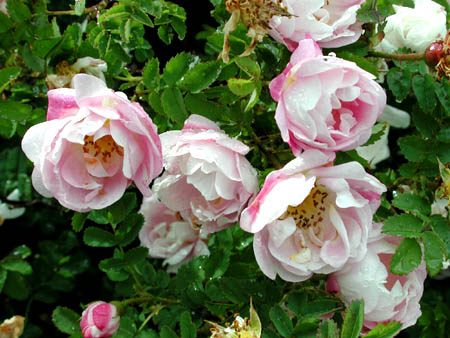
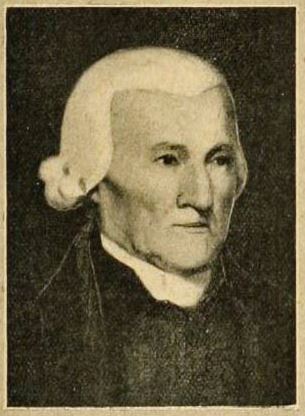
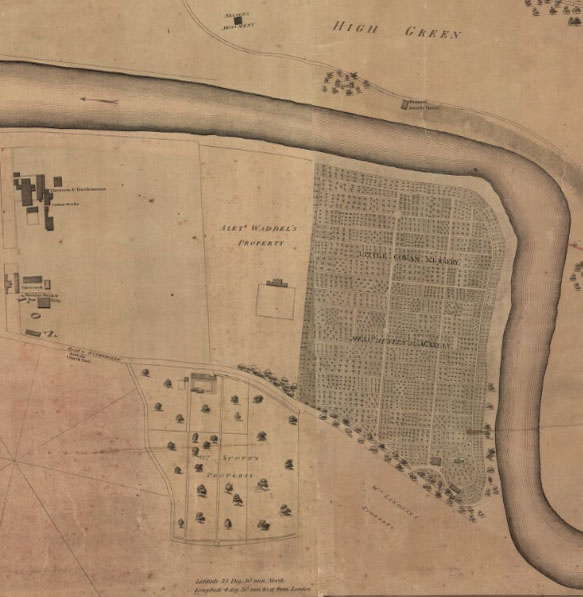

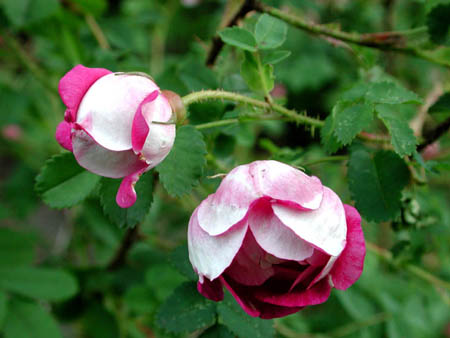
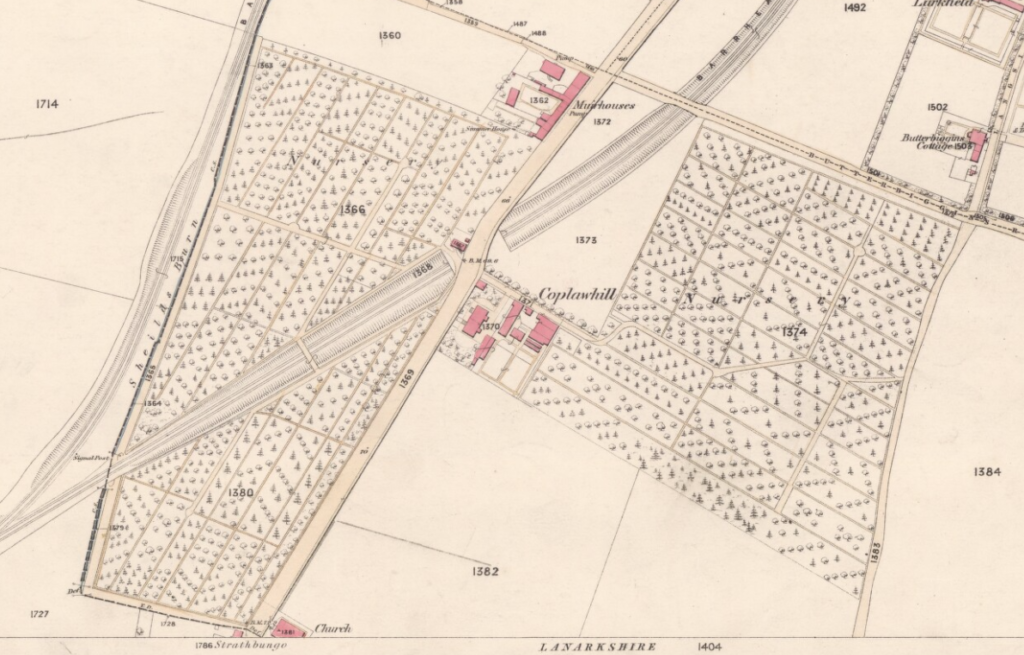


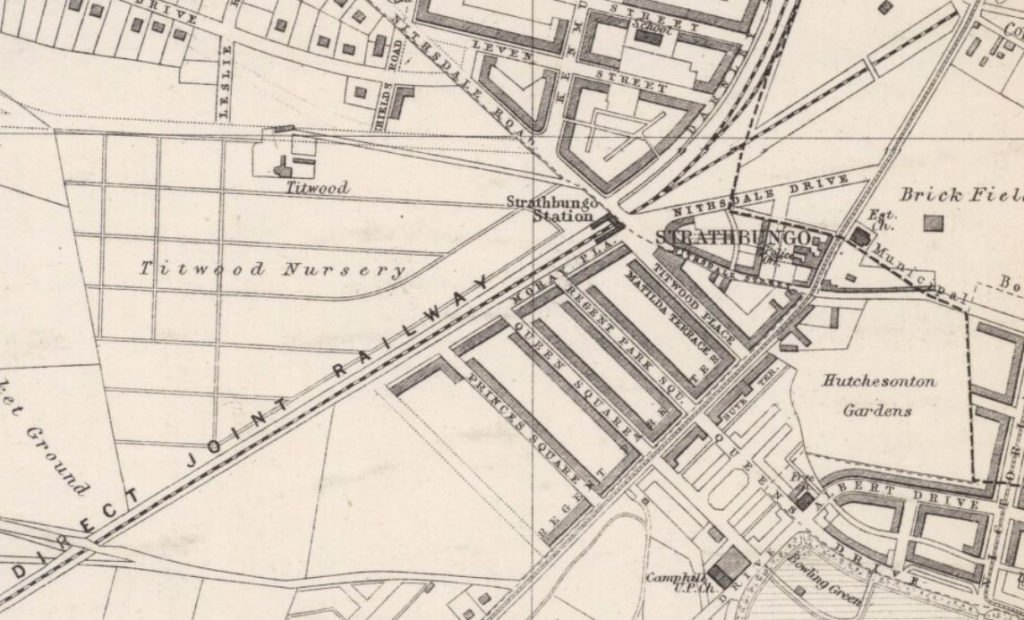
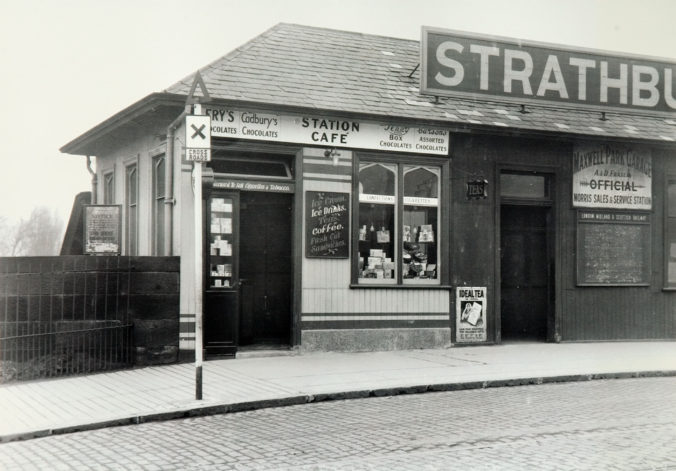

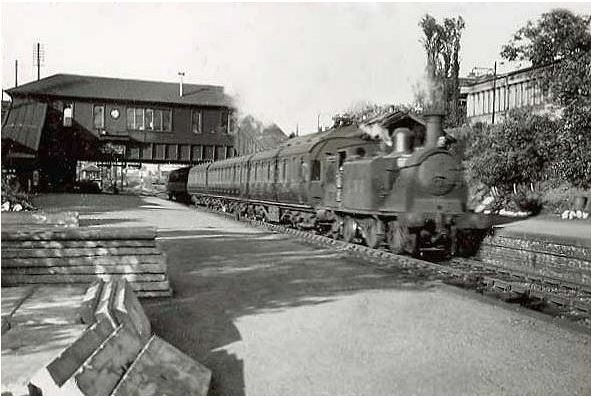
Recent Comments